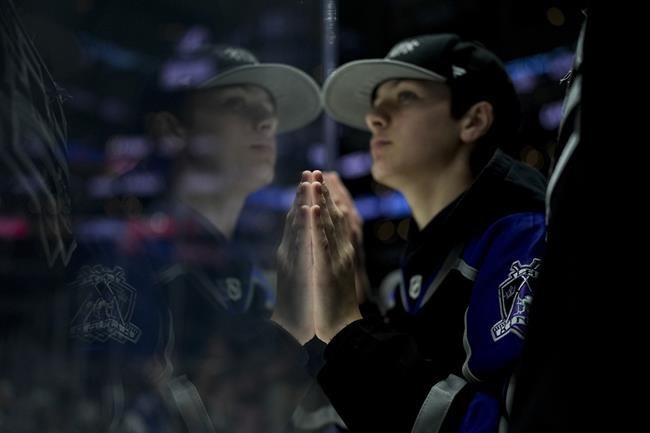NEW YORK (AP) — Arenas are full, the NHL is a fixture on TV screens across North America, highlight-reel goals are talking points on a near-daily basis and “The Pat McAfee Show” even has a segment called “Hockey is Awesome."
Piece it all together, and more eyes are on the puck than ever before with the playoffs beginning this weekend.
Business is booming for the NHL, which has bounced back in a major way from the pandemic. Backstopped by new media rights deals, digital dasher boards and helmet and jersey ads, and buoyed by an overlap of generational stars, ratings are up, attendance set a record and revenue is at an all-time high — an estimated $6.2 billion annually.
“The league is going through a bit of a renaissance,” said Tom Gargiulo, chief marketing officer at Bodyarmor, whose deal to be the league's sports drink is the latest sponsorship agreement inked in recent years. “This sport is moving into the next phase of its evolution and is on a tremendous trajectory.”
Commissioner Gary Bettman says it starts with the game on the ice, which he believes has “never been more exciting, more competitive, more skillful, never been faster.” There are nearly six goals a game on average, and while Sidney Crosby and Alex Ovechkin are still producing, Connor McDavid, Auston Matthews and Nathan MacKinnon are in their prime with another wave of talent led by the likes of Connor Bedard not far behind.
NEW FANS
Showcasing star players better than before in the team-first sport has helped, and 22.5 million fans have filled arenas to 97% capacity. League officials are quick to credit ESPN and Turner for buying in, and viewership is up 7% for the most-watched NHL season on cable in 30 years.
“We’ve seen an influx and a growth of female fans, diverse fans,” senior VP of North American business development Kyle McMann said. “They’re finding our product, they’re falling in love with it, they’re starting to watch more.”
Trying new things, including puck and player tracking and cartoon versions of games to draw in younger fans, has set the table for this success. Decades since the experiment of the glowing puck, experts credited the league for attracting and retaining a bigger audience in a crowded sports marketplace.
“They keep doing stuff that’s innovative to keep their audience engaged,” said Lauren Anderson, director of the Warsaw Sports Business Center at the University of Oregon. “The NHL could’ve fallen back on being pretty traditional, and I think they haven’t been afraid to try some things and pivot even when it didn’t work."
Salvatore Galatioto, who runs a sports finance and advisory firm and is a marketing professor at Columbia, said the league has done a good job reaching beyond traditional markets, overcoming some of the unavoidable shortcomings of being expensive to play.
“It’s not rocket science: It’s the number of eyeballs watching your product,” he said. “They have done a really good job of expanding their fanbase, and that’s the key."
SELLING THE GAME
Chief NHL Content Officer Steve Mayer has made that his life's work since joining in 2016, coming up with new and different ways to present a more-than-century-old sport, from the 2020 playoff bubble to outdoor games and a reimagined All-Star weekend.
“We’re not here to change the game,” Mayer said. “We’re here to enhance what is out there and to get it in front of more people because we know that if people watch our game, they’re going to fall in love with it.”
Central to the game are the players, and none of this would be possible without a constructive working relationship with the NHL Players' Association, which may be at its most cooperative stage in decades. The league and union found common ground in extending the collective bargaining agreement through 2026, getting back to the Olympics and launching another international competition next year featuring the U.S., Canada, Sweden and Finland.
“It’s a key to moving forward,” union executive director Marty Walsh said. “When I first started, I had a conversation with Gary Bettman, and our teams talked about working together and growing hockey-related revenue, growing the sport. ... We’re all vested in one direction.”
WORK TO DO
The NHL still has work to do to catch up with the NFL ($18.6 billion in revenue in 2022), NBA ($12 billion) and Major League Baseball ($11.6 billion), but it's not unrealistic to think $10 billion is attainable before the end of the decade.
“We plan on getting there — how and when, obviously, will take some time," chief business officer Keith Wachtel said. "Looking at hockey a bit differently than perhaps it was looked at a decade ago. It’s still the ultimate team sport, but we have such great players and personalities."
One challenge is getting fans who are focused on their own team to watch others. There's evidence that is also starting to turn, with Bedard (Chicago) and Artemi Panarin (New York Rangers) jerseys the highest-selling this season and good ratings even when Canadian teams are on national television in the U.S.
Executive VP Marketing Brian Jennings, who has been at the NHL for 33 years, said there is no shortage of people “knocking on the door" to get in on the boom.
"The constellation of those stars have aligned,” Jennings said. “When we look at our glide path and say, ‘Hey, how bright is the future?’ It’s really bright.”
___
AP NHL: https://apnews.com/hub/nhl
Stephen Whyno, The Associated Press



